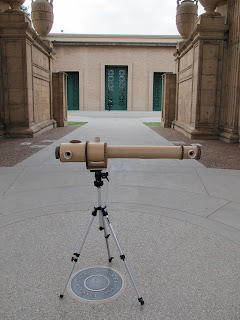In my continuing quest for a brighter cheaper simpler projector for the graffiti projector concept, I realized that going lensless is the only way to really achieve this. Lenses are in my experience cheap when they don't meet your specifications and expensive when they do. On top of that you have to build a precise structure to keep them aligned and usually need more than one for good image quality. I first encountered the idea of a point source projector when I read about Jim Sanborn's Cyrillic Projector you can read more about it
here (the pieces A Comma and Lux use a similar technique).
The most basic way to achieve this is to get a very small bright light source and shine it through a cut out. This works well and gives the theoretically maximum brightness at the cost of having no control over throw length. The closer the projection surface to the projector the brighter and smaller the image. You can't get a bright image very far away as the brightness is governed by the inverse square law. While this is not a great characteristic it is tolerable for the short throw applications I had in mind. The real problem with cutouts is the typical stenciling problem of islands created when you have concentric rings of positive and negative space as seen above.

You can solve this by using a grid of separate half tone dots or using a simplified image with bridges as in a typical stencil, like the A above. I didn't want to do that much post processing of images, so instead I look to another familiar print making technique screen printing. Screen printing avoids the problems of islands by suspending the masked zones in the permeable matrix of the screen. After thinking about this for a bit I wondered if it might be possible to make a plexiglass mirror selectively reflective, by removing the reflective backing in places and relaying on the acrylic to act as the matrix. Sounds simple but I wasn't at all sure it would work. I could print some resist on the back and sand blast it, or laser etch it and risk warping and melting. In the end I went for laser etching, what I found was that as long as the image was not to detailed the mirror would not warp or melt significantly.

Here was the first attempt (I believe it was a picture of Hamilton) turned to be too much detail and the mirror backing oxidized and the acrylic warped.
Here was second one I tried it didn't warp but the mirror back didn't get completely clean in the negative space either.
To use the projector you just have to shine your point source at the etched mirror at a shallow angle.
I used loc-line coolant hose to allow easy adjustment of the light sources position, and made a simple wooden platform to hold the mirror slide and the led driver. The led I used was the brightest and smallest one I could find, a
Cree xp-g lamp it has a 3mm emitter and driven at .75 to 1A can throw a clearly visible 5' image from about 10' in dim light.
Here's a detail of the led and its aluminum heat sink cube.
Here is a detail of the mirror slide projection. It achieves finer detail than a cutout, but still has its defects, you can see patches of oxidation at the bottom of the letters and in general the image can't achieve the crispness of a stencil projection. What is Dec, unremarkably I needed some short words and happened to be making it last December so decided to use Dec in the most decorative gothic font I could find.



















































